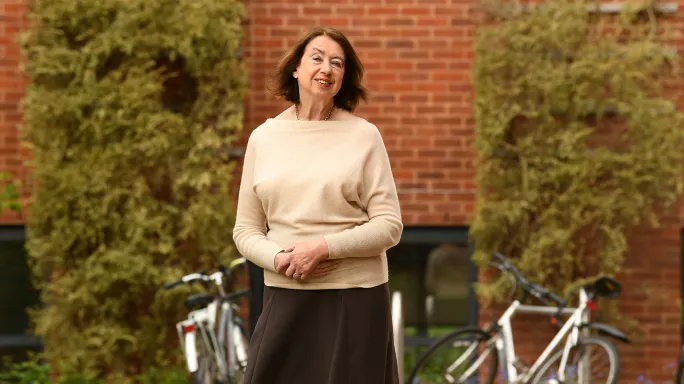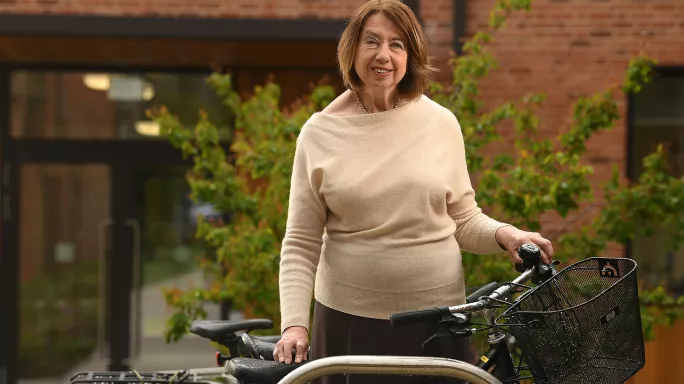
- Home
- Teaching & Learning
- General
- Group work: why it works and how to do it well
Group work: why it works and how to do it well

“It’s often thought that dialogic teaching means doing lots of group work. The truth is that it’s not just any old group work. If you set up a group in which everyone has the same opinion, there’s no controversy - there’s nothing to discuss, and nobody will learn anything. But if you put students together who have different opinions, they can gain so much from that interaction.”
Christine Howe, emeritus professor of education at the University of Cambridge, has spent decades researching dialogic teaching, and she’s convinced that the benefits of it can be significant.
Popularised in the UK in the 2000s by researcher Robin Alexander and others, the approach aims to raise pupil engagement and attainment by improving the quality of classroom talk.
And yet, despite being a staple of initial teacher training courses and the Early Career Framework, the principles of dialogic teaching are not being universally, or even widely, used in schools, says Howe.
Tes sat down with her to find out why this might be, and how teachers can successfully embed the approach in their classrooms.
Tes: What is dialogic teaching?
Christine Howe: In essence, dialogic teaching draws out ideas and thoughts that students have, gets them to share and build on these, negotiate their differences in a reasoned fashion and then gently eases them towards a richer understanding.
The key is student empowerment, which was introduced by the Brazilian researcher Paulo Freire, who was the “founding father” of dialogic methods.
That makes it sound quite straightforward. Why, then, isn’t the approach more widely used?
It’s a combination of things. The current conception of dialogic teaching is overly complex - and as researchers, we are partly to blame for this. We try to run before we can walk and introduce teachers to too many factors simultaneously. It can sometimes seem a little overwhelming and even contradictory.

As a result, there’s not always a good understanding of what the crucial variables are. And that is perhaps why dialogic teaching isn’t being universally used.
Which aspects of the approach tend to get lost in practice?
The need to allow students to reach that deeper understanding; teachers don’t always give enough space for this to happen.
One bugbear of mine is when students are expressing ideas in response to a string of teacher questions. This means they don’t share and negotiate with each other; instead, their interaction is with the teacher.
So, although the students may be expressing very interesting ideas, they don’t have the opportunity to explore issues with each other and try to resolve these. Often, the teacher gives instant feedback to these responses, which means that you lose the space for students to explore and really consider their argument.
How can we avoid this kind of classroom talk?
One of the most effective practices is group work: when a teacher raises a question or issue, students need time to thrash it around in small groups so they can understand each other’s thinking, resolve differences and so forth.
They can then report these findings back to the class, so the teacher hears about the disagreements that have taken place and can build on these.
Is group work a key element of dialogic teaching?
Definitely. For dialogic teaching to be successful, there needs to be meaningful group work.
It isn’t the be-all and end-all; modes of teacher-student dialogue are important, too. But group work is crucial to bringing about lasting change in knowledge and understanding because the starting point is students’ own thinking.
‘Leave time for beyond-group sharing. It’s during this that great teacher-student dialogue comes into play’
Teachers should have a very clear idea of what they’re hoping to achieve in a lesson, but start with a student’s perspective before then moving towards the teacher’s goal.
Why is group work so valuable?
In my work, I’ve always looked at learning outcomes and have always tested students two or three weeks after they have taken part in the group work sessions. I’ve also looked at results on public assessments; if the group work has specific features, progress is guaranteed, including with Sats.
That’s not to say that students will get to the perfect solution during group work. For example, a group of nine-year-olds won’t come up with a perfect analysis of why objects sink and float in water, but you will get progress, which teachers can then build upon.
And, of course, when they leave school, students will almost certainly go to work in team-based environments, so it’s important they learn to interact constructively and positively, regardless of gender, socioeconomic status, etc - so that’s an additional long-term benefit, quite apart from the ones for knowledge and understanding.
How do we embed effective group work in the classroom?
It’s tough, and I do think teachers sometimes need more training on the key variables that are absolutely crucial to effective group work.
For example, creating contexts in which students have different views is important. If you have a group where they all believe the same, they often hardly talk at all, and there’s absolutely no progress. This can easily happen in groups of the same ability.
Teachers also need to set up a task where students negotiate their positions and give reasons for their differing views, and are then obliged to come to a consensual view. Importantly, it does not matter whether this consensual view is actually correct.
Should group work be used in every lesson?
Why not? In my most recent study, we went to 72 classrooms in different parts of the country, which varied enormously in terms of student demographics. In 71 of them, they used group work, to varying degrees, in every single lesson. It’s already happening in British schools.
Some critics of group work say that these tasks are often dominated by a small number of children. Have you found this?
That can happen, and that’s why you have to carefully structure the group work instructions to maximise participation from everyone.
But there have been findings that show that boys dominate over girls, and there are other reasons why some students might be more dominant than others.

Many years ago, one of my doctoral students found that when a child with special educational needs or disabilities was put in a leadership role in group work, it influenced the patterns of domination to the extent where, sometimes, the other students were quite rude. You can hear it on the videotapes, the other two students saying: “Well, you know, so-and-so can’t do this.”
The point I want to stress, though, is that while such problems can occur during group work, they are not inevitable.
What can teachers do to avoid these problems?
Teachers need to be very deliberate and structure the task to ensure everyone has their say: for example, setting ground rules, such as making sure that everyone has time to say what they think and that everyone is listened to.
Another successful technique is asking students to write down their views on a piece of paper before the discussion starts. This means that everyone has something to add, and students can’t hide behind not having an idea.
Is there an optimum number of pupils for each group?
I’d say groups should be in the range of two to five, with five being the maximum.
It depends on the activity, though. If it’s a computer-based task, for example, I tend to use relatively small groups, just because of the practicalities of having children using a single screen.
Rather than size, teachers should consider the composition of the groups: not just in making sure there’s a range of opinions, but in terms of making sure it’s not the same group of children each time.
So, the groups should be rotated?
Yes. Recently, I’ve been looking at classrooms in which students begin working in one group, and then move to another - and tell this second group the thinking of their initial group. This can be repeated several times. That’s a really good way to solidify students’ knowledge and encourage them to engage with others.
‘Good group work is already happening in British schools. It’s not a pipe dream, it is doable’
This is called “beyond-group sharing”, and can also happen when groups take turns to report back to the whole class, with the teacher involved. The common factor is that students are forced to think about what they’ve just been discussing and put it together; that’s great for those metacognitive skills.
Is group work effective at any age?
My research shows that group work is effective with primary, secondary, further and higher education pupils, and I’ve found that the same variables are relevant to success across a wide age range.
However, my work with primary school students has been with the over-sevens, and I’m not sure how well things would work with younger children.
I have observed the free play of children with their peers in early years foundation stage settings, and I’ve seen them using the dialogic behaviours that I have shown to be productive with older children, but I never put them in formal groups. I think below the age of 7, children would struggle with both reading written instructions and some aspects of the reasoning involved.
How long should the group work last?
It depends on the topic. I have seen some group sessions take 40 minutes of an hour’s lesson and others 10 minutes, and both can be effective. The key is that the task is conducive to the features I’ve been talking about.
Teachers also need to remember to leave time for beyond-group sharing, as this encourages reflection and building upon what happened in the group. It’s during this sharing that great teacher-student dialogue also comes into play.
What’s the key to making that teacher-student dialogue a success?
My research found that the crucial thing is to set up a context where there are high levels of student participation. This can happen in a plenary session, where students report on their group work, for instance.
Once you have student participation, two further things need to happen: firstly, the student’s contributions need to be elaborated upon, either by other students or by the teacher; and secondly, there needs to be questioning of the ideas expressed. If you can do that, it will pay dividends.

Once those principles are embedded, you can introduce some other strategies associated with dialogic teaching.
Such as?
Teachers could, for example, synthesise the different views that students express, or encourage their synthesis. This means very deliberately saying something like: “Mary had this view, and Jonny had this view. How can we bring them together?”
That process actually doesn’t happen very often in classroom talk - as the study we conducted in 72 classrooms showed.
What are the key things you want teachers to understand about improving the quality of the talk that happens in their classrooms?
Good group work is already happening in British schools, not necessarily universally, but in many, many classrooms. It’s happening, and therefore it’s achievable. It’s not a pipe dream, it is doable and it involves students with differing opinions expressing those, justifying their position and coming towards a consensual view.
But good group work isn’t enough alone: students also need to be encouraged to reflect on group work, either by joining other groups of students or explaining through a plenary session. There also needs to be high student participation, elaboration, querying and reasoning.
For me, dialogic teaching could be at the heart of every classroom, and to do that, teachers need to recognise the importance of deploying group work and teacher-to-pupil dialogue more intentionally, and more effectively.
You need a Tes subscription to read this article
Subscribe now to read this article and get other subscriber-only content:
- Unlimited access to all Tes magazine content
- Exclusive subscriber-only stories
- Award-winning email newsletters
- Unlimited access to all Tes magazine content
- Exclusive subscriber-only stories
- Award-winning email newsletters
You need a subscription to read this article
Subscribe now to read this article and get other subscriber-only content, including:
- Unlimited access to all Tes magazine content
- Exclusive subscriber-only stories
- Award-winning email newsletters
- Unlimited access to all Tes magazine content
- Exclusive subscriber-only stories
- Award-winning email newsletters
topics in this article



